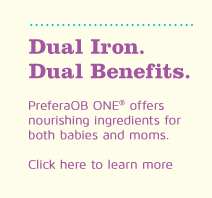INDICATIONS AND USAGE: PreferaOB ONE® is a prescription multivitamin/multimineral nutritional supplement with Omega-3 fatty acid (life'sDHA™) indicated for use in improving the nutritional status of women throughout pregnancy and in the postnatal period for both lactating and non-lactating mothers. PreferaOB ONE® is also beneficial in improving the nutritional status of women prior to conception.
IMPORTANT SAFETY INFORMATION
WARNING: Accidental overdose of iron-containing products is a leading cause of fatal poisoning in children under 6. Keep this product out of reach of children. In case of accidental overdose, call a doctor or poison control center immediately.
CONTRAINDICATIONS: This product is contraindicated in patients with a known hypersensitivity to any of the ingredients.
WARNING: Ingestion of more than 3 grams of Omega-3 fatty acids per day has been shown to have potential antithrombotic effects, including an increased bleeding time and International Normalized Ratio (INR). Administration of Omega-3 fatty acids should be avoided in patients taking anticoagulants and in those known to have an inherited or acquired predisposition to bleeding diathesis.
PRECAUTIONS: Folic acid when administered as a single agent in doses above 0.1 mg daily may obscure pernicious anemia in that hematological remission can occur while neurological manifestations remain progressive. Pregnant women and nursing mothers should avoid supplemental doses of vitamin E higher than RDA amounts. While prescribing this nutritional supplement for pregnant women, nursing mothers, or for women prior to conception, their medical condition and other drugs, herbs, and/or supplements consumption should be considered.
ADVERSE REACTIONS: Allergic sensitization has been reported following both oral and parenteral administration of folic acid.
You are encouraged to report negative side effects of prescription drugs to the FDA.
Visit www.fda.gov/medwatch or call 1-800-FDA-1088.
Please see Full Prescribing Information.
References
1. National Institutes of Health. Office of Dietary Supplements. Dietary supplement fact sheet: iron. http://ods.od.nih.gov/factsheets/iron. Accessed April 3, 2012. 2. Frykman E, Bystrom M, Jansson U, Edberg A, Hansen T.
Side effects of iron supplements in blood donors: superior tolerance of heme iron. J Lab Clin Med.
1994;123(4):561-564. 3. Lee KA, Zaffke ME. Longitudinal changes in fatigue and energy during
pregnancy and the postpartum period. J Obstet Gynecol Neonatal Nurs. 1999;28(2):183-191. 4.
Zimmerman MB, Hurrell RF. Nutritional iron deficiency. Lancet. 2007;370(9586):511-520. 5. Ekman M,
Reizenstein P. Comparative absorption of ferrous and heme-iron with meals in normal and iron deficient
subjects. Z Emahrungswiss. 1993;32(1):67-70. 6. National Institutes of Health. Office of Dietary
Supplements. Dietary supplement fact sheet: vitamin B6. http://ods.od.nih.gov/factsheets/VitaminB6-
QuickFacts. Accessed April 3, 2012. 7. Davis M. Nausea and vomiting of pregnancy: an evidencebased
review. J Perinat Neonatal Nurs. 2004;18(4):312-328. 8. American College of Obstetrics and
Gynecology. ACOG (American College of Obstetrics and Gynecology) Practice Bulletin: nausea and
vomiting of pregnancy. Obstet Gynecol. 2004;103(4):803-814. 9. Office of Dietary Supplements. National
Institutes of Health. Dietary supplement fact sheet: vitamin B6 for healthcare professionals. http://
ods.od.nih.gov/factsheets/vitaminb6. Updated September 15, 2011. Accessed December 7, 2011. 10.
US Department of Health and Human Services. Office on Women’s Health. Frequently asked questions:
folic acid. http://www.womenshealth.gov/publications/our-publications/fact-sheet/folic-acid.pdf. Updated May 18, 2010. Accessed December 7, 2011. You'll need the Adobe®
Acrobat® Reader in order to view this document. You can download it for free here http://get.adobe.com/reader/. 11. The American Congress of Obstetricians and
Gynecologists. Frequently asked questions: healthy eating. FAQ130. http://www.acog.org/publications/faq/faq130.pdf. Published August 2011. Accessed December 7, 2011. You'll need the Adobe® Acrobat®
Reader in order to view this document. You can download it for free here http://get.adobe.com/reader/. 12. University of Maryland Medical Center. Medical
reference: docosahexaenoic acid. http://www.umm.edu/altmed/articles/
docosahexaenoic-acid-000300.htm. Last reviewed September 20, 2010. Accessed April 3, 2012. 13.
Hibbeln JR. Seafood consumption, the DHA content of mothers' milk and prevalence rates of postpartum
depression: a cross-national, ecological analysis. J Affect Disord. 2002;69(1-3):15-29. 14. Smuts CM,
Huang M, Mundy D, Plasse T, Major S, Carlson SE. A randomized trial of docosahexaenoic acid
supplementation during the third trimester of pregnancy. Obstet Gynecol. 2003;101(3):469-479.







